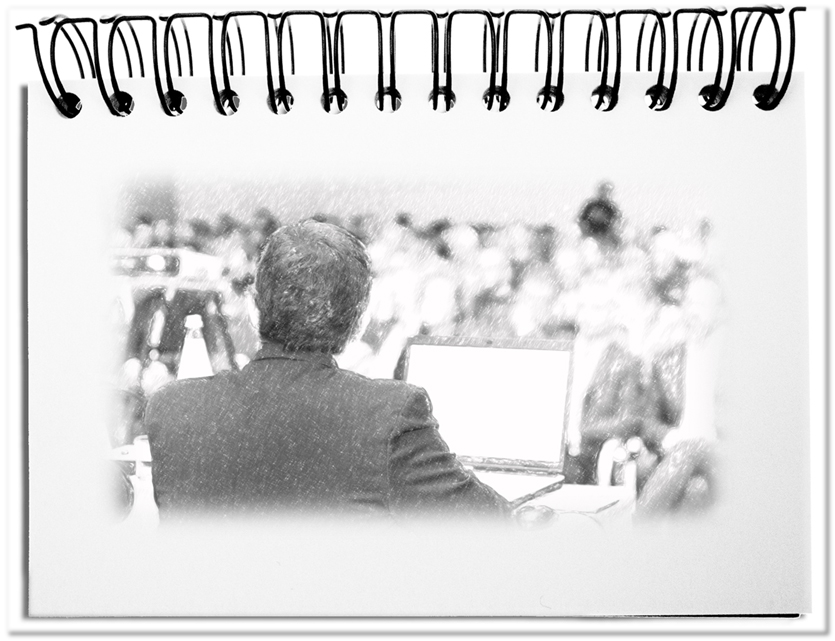The path to the completed presentation does not begin with the scheduling or the elaboration of a topic or the preparation of the documents. The beginning lies hidden in a time when the interest in a subject area evolved. Eventually the lecture takes place in front of an interested audience. The contents are tailored to the occasion, formulated, visualized and equipped with suspense. The posture, facial expressions and gestures as well as the tone of voice during a lecture underline the relationship of the speakers to their presentation. And between the lines you will find the speaker’s intentions, regardless of the topic – an additional puzzle piece for a better understanding.
Even if this part of a lecture is often covered by the show and the contents, the audience unconsciously perceives these aspects. Presenters should be aware of what they intend to do in advance, to package their facts appropriately. By consciously observing this space in between, the audience is offered more clarity regarding the intentions of the lecture. Thanks to John Searle, there are five generalized speech acts that reveal the expectations of the speaker.
- Statement – Saying, how it is
The main purpose of describing facts is to inform the public. For this purpose, statements are formulated, which consist of numbers, data and facts, explanations and conclusions as well as arguments for or against a point of view. The view goes back to the past or describes a current situation or predicts future developments. You can confirm, correct or deny assertions.
Saying, as it is, conveys circumstances from the speaker’s point of view to the audience.
Examples: argue, assert, communicate, conclude, correct, deny, determine, disprove, inform, predict, report - Solicitation – Saying, what to do
Presentations can be used to motivate the audience to act. A wide range of (in)direct impulses is available for this purpose. They range from the allusion, the recommendation and request to the command. Restrained speakers will make subtle hints. A piece of advice offers meaningful outcomes that someone only has to take and realize. In order to make its wish clearer, the listener’s insight can be appealed to or even asked for support. The next step is to clearly delegate or commission certain individuals.
Saying, what to do, indicates the tasks to be completed.
Examples: admonish, advise, allow, ask, call, command, demand, forbid, invite, order, persuade, plead, request, suggest, threaten - Commitment – Saying, what you’re doing
A powerful propulsion convey messages that show what you are willing to do. These commitments are later observed by the audience, in order to check the speaker’s credibility against his future acts. Promises can be assurances or threats.
Saying, what you’re doing, and adhering to it, is a powerful tool for directing large groups.
Examples: agree, announce, assure, bet, commit, confirm, ensure, guarantee, insure, offer, pledge, promise, serve, swear, vow - Psychic condition – Saying, how you are doing
The expression of one’s own feelings offers the opportunity to make emotional contact with the audience. These messages are less processed by the audience with reason than with the sixth sense. The whole range of emotions can be found here: from sad to happy, from disappointed to satisfied, from angry to joyful. The content can discredit or praise someone. You can complain about facts or being thankful for them. That way it is possible to communicate your state or to apologize for something.
Saying, how one is doing, has a subliminal effect and, in a positive case, promotes cohesion.
Examples: apologize, approve, blaspheme, cheer, compromise, condone, congratulate, defame, express condolence, glorify, greet, lament, mock, praise, scold, thank - Declaration – Saying, what is officially valid
The announcement of formal messages determines, what is fixed from that moment. This may involve the proclamation of new rules or contracts, the dismantling or filling of a position or the release of a decision. It may refer to external or internal circumstances.
Saying, what is officially valid, announces realities that are formally established.
Examples: abdicate, appoint, baptize, cancel, dismiss, outlaw, pardon, release, resign, suspend, trust
Bottom line: In addition to contents and presentations, the intentions form an additional puzzle piece for interpreting circumstances – the intentions hidden in the messages. Just as in any description, Searle’s five speech acts are also included between the lines of each dialogue: statement, solicitation, commitment, psychic condition, and declaration. The speakers and the audience can use these patterns consciously for their own purpose. The lecturer ensures that his desired intentions become visible. The listeners use the conscious look at the wording for recognizing the intentions of the speaker on the basis of the verbs used. This provides all participants with an additional puzzle piece for a better understanding of expressions.

